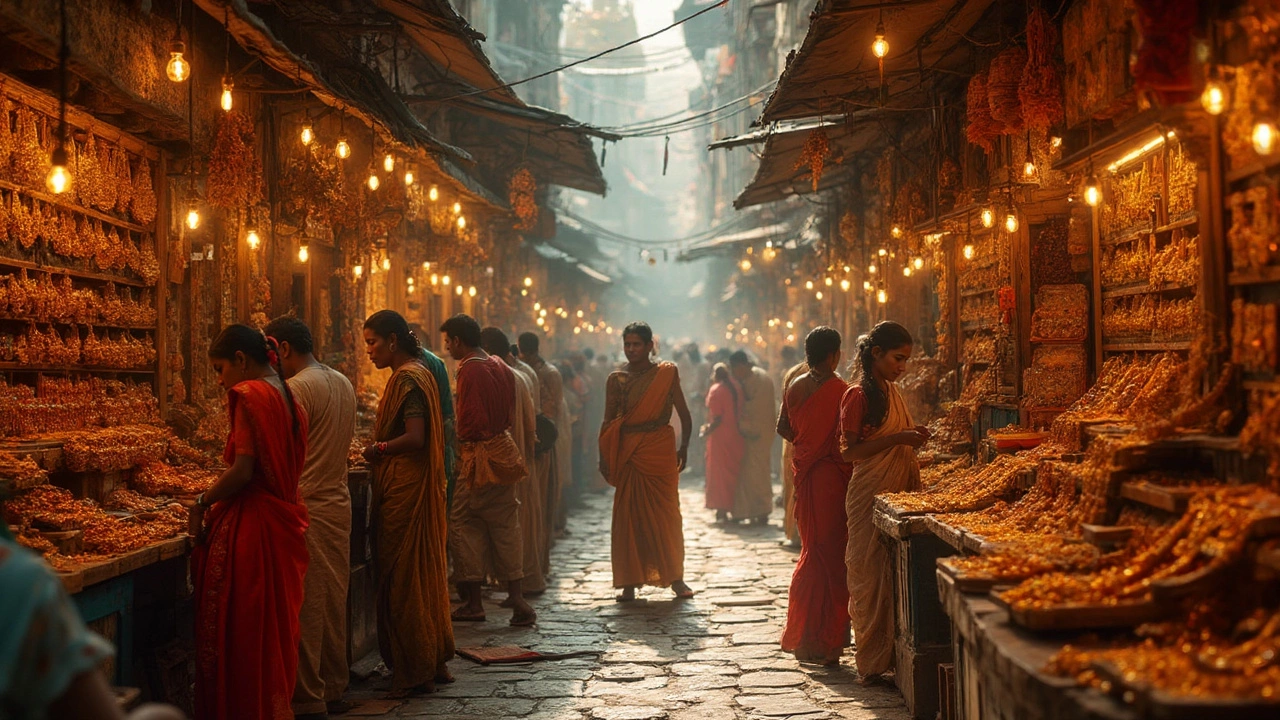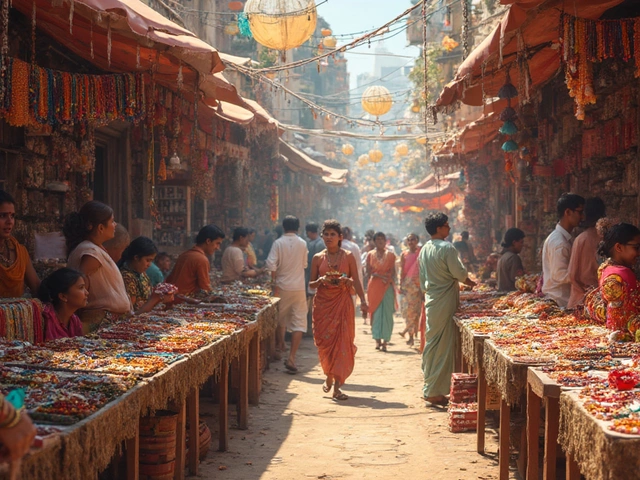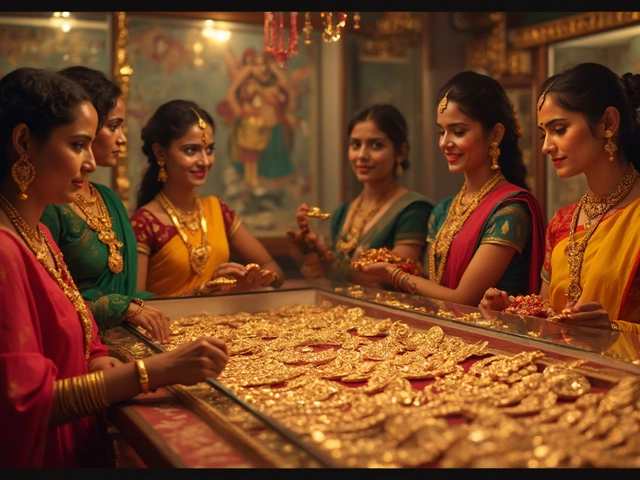
If you’re on the hunt for the real heart of Indian jewelry, Chennai always tops the list. Walk through the bustling markets or stroll down T. Nagar, and you’ll see jewelry shops lined up like stars—each offering unique designs you won’t find anywhere else in India. Chennai’s reputation isn’t just hype; it’s the home of authentic temple jewellery, a style that blends tradition with rich craftsmanship.
What makes this place truly stand out? It’s not just sheer variety. Artisans here have passed down their skills for generations, turning gold and gems into statement pieces often used in classical dance and temple rituals. Whether you want something heavy with history or just pretty to show off, Chennai has a piece waiting for you.
- Chennai: Jewel of the South
- Temple Jewellery – What Sets It Apart?
- Historic Roots and Interesting Traditions
- Hotspots for Buying Authentic Pieces
- Tips for Choosing Genuine Jewellery
- Modern Twist on Ancient Craft
Chennai: Jewel of the South
When people think of Indian jewelry, Chennai almost always comes up first. You’ll find this city on India’s southeast coast, serving as the center for some of the oldest and most loved jewelry trades in the country. But what shoots Chennai straight to the top is its unbeatable variety in gold, diamonds, and—especially—temple jewellery. In fact, Chennai is so tied to temple jewellery that many classical dancers across India come here just to buy their performance sets.
The famous T. Nagar neighborhood is packed with jewelry stores, sometimes getting more than 200,000 shoppers a day before wedding seasons or festivals. Big names like GRT Jewellers, Saravana Stores, and Prince Jewellery started right in Chennai and now have branches across India and beyond. Even non-locals plan trips just to shop for engagement and wedding sets here because of Chennai’s reputation for solid gold work and quality stones.
- Chennai is India’s largest jewelry retail market by sales volume.
- The city’s temple jewellery workshops have been active for over 200 years.
- About 70% of South India’s wedding jewelry is made or sold here.
The city’s jewelry business isn’t just tradition. It’s big business—Chennai exports significant pieces to the US, UK, and Singapore. Handmade gold work, in particular, pulls in buyers who care about craftsmanship more than just design. Jewelers here are famous for customizing sets to fit just what you’re looking for, whether that’s a simple thali or an elaborate set for Bharatanatyam performances.
| Stat | Number/Facts |
|---|---|
| Major Jewellery Retailers | 2000+ in Chennai city alone |
| Average Annual Jewellery Sales (2024) | ₹45,000 crores |
| Exports Market | US, UK, Singapore, Middle East |
| Main Types Crafted | Temple jewellery, gold, diamond, platinum |
If you want the best and most authentic Indian jewelry, Chennai should be on your radar. Check out local bazaars, but don’t ignore small family-run workshops either. Sometimes those are where the real treasures are hiding.
Temple Jewellery – What Sets It Apart?
Temple jewellery isn’t just metal and stones—it’s a symbol of culture and history straight from the heart of South India. The main thing that separates temple jewellery from other kinds is its use in classical Indian dance forms like Bharatanatyam and Kuchipudi, as well as in temple rituals. You’ll spot these pieces by their bold designs, usually shaped like gods, goddesses, and sacred motifs. No surprise, Chennai is where most of the genuine pieces come from.
What stands out? For one, traditional temple jewellery designs stick to pure gold. Sometimes they’re decorated with rubies, emeralds, or pearls. You’ll often see big, chunky necklaces (odiyanam), long earrings (jhumkas), delicate hairpieces, and broad bangles. These aren’t just for show—some families pass them down like heirlooms. Plus, each piece takes serious time to make, combining handmade techniques that go back hundreds of years.
The making of temple jewellery still relies on craftsman skills. Unlike flashy, mass-produced ornaments, these pieces are hand-carved with impressive attention to detail. If you run into an authentic craftsman in Chennai, you’ll notice small imperfections—that’s how you know it’s handmade and not something churned out by a machine.
If you’re curious about how temple jewellery compares to other popular types from India, check out this quick table:
| Type | Main Material | Common Uses | Main City |
|---|---|---|---|
| Temple Jewellery | Gold, Rubies, Pearls | Dance, Temples, Weddings | Chennai |
| Kundan | Gold, Polished Glass | Bridal, Festive Wear | Jaipur |
| Meenakari | Enamelled Gold | Bridal, Everyday | Bikaner/Jaipur |
| Polki | Uncut Diamonds | Weddings, Investment | Jaipur |
Picking temple jewellery isn’t all about looks. If you join a dance troupe or want a piece of heritage, go for something with mythological designs and solid craftsmanship. That’s where the real value lies.
Historic Roots and Interesting Traditions
Temple jewellery has roots that go way back to the Chola dynasty, around the 9th century. Back in those days, goldsmiths in Chennai and nearby areas made intricate jewellery specially for gods and goddesses in South Indian temples. These pieces didn’t just hang out in showcases—they played a big part in religious festivals and were seen as offerings for blessings. Even now, you’ll spot almost the same styles in the statues and temple processions, especially in places like Kapaleeshwarar Temple in Chennai.
What really makes temple jewellery different is the attention to detail and the use of traditional motifs. Designs like lotus flowers, peacocks, and mythical creatures (like yalis) are everywhere in these pieces. It’s also where you’ll find a lot of rubies, emeralds, and uncut diamonds set in chunky gold frames. Here’s a quick look at common motifs and what they mean:
- Indian jewelry designs: Lotus for purity, peacocks for beauty, and parrots for vibrancy.
- Vanki (armbands): Worn by dancers; shows off status and tradition.
- Oddiyanam (waist belts): Meant to keep sarees in place and symbolize protection.
The tradition has held up strong thanks to Bharatanatyam dancers and families who still collect temple jewellery for weddings. It’s not just about looks—these pieces are seen as good luck and are often passed down as family heirlooms.
If you’re a numbers person, check this out:
| Fact | Details |
|---|---|
| Origin | Chola Dynasty (9th-13th century) |
| Main Materials | Gold, rubies, emeralds, pearls |
| Key Markets Today | Chennai, Kanchipuram, Madurai |
| Common Motifs | Lotus, peacock, deity faces |
Don’t be surprised if a single temple jewellery piece in a Chennai shop takes several weeks to handcraft. That’s not just about the look—it’s about keeping real tradition alive, piece by piece.

Hotspots for Buying Authentic Pieces
If you're serious about temple jewellery in Chennai, you need to know where to shop. The best spots aren’t tucked away in narrow alleys—they’re actually landmarks in the city’s shopping world. T. Nagar, especially Usman Road and Ranganathan Street, is famous for having the highest density of jewelry showrooms in India. These streets are packed year-round; during peak wedding season, the crowd triples.
When you walk into big names like GRT Jewellers, Lalitha Jewellery, and Prince Jewellery, you see why locals trust them. They offer every style from antique temple pieces to modern adaptations, and they’re known for their certified gold and transparent pricing. If you want something with more tradition and less glitz, try the tried-and-tested shops in Mylapore. Stores here often specialize in dance jewellery—perfect if you’re looking for Bharatanatyam or Kuchipudi pieces with history behind them.
- Indian jewelry stores in Sowcarpet are another favorite. This area buzzes with smaller family-run outlets where you might get custom designs at competitive rates.
- Pondy Bazaar is popular for younger shoppers who want trendy twists on classic jewelry, and prices here are usually a bit more flexible.
- If you’re short on time, large retail chains have sections dedicated just for temple jewellery, which makes comparison-shopping much easier.
Take a look at how these hotspots stack up:
| Area | Main Attraction | Typical Crowd | Famous For |
|---|---|---|---|
| T. Nagar | Multi-storey showrooms, endless designs | Heavy, especially during festivals | Latest temple jewellery, classic gold pieces |
| Mylapore | Heritage shops, dance/artisan jewelry | Art lovers & old-school buyers | Bharatanatyam pieces, silver jewelry |
| Sowcarpet | Family-run stores, customization | Locals & bargain-hunters | Unique, one-off designs |
| Pondy Bazaar | Trendy boutiques, street stalls | Younger crowd | Modern spins on classic styles |
Pro tip: Always ask for a hallmark certificate when buying gold, especially in the bigger stores. Don’t be afraid to compare prices between showrooms—they’ll often match or beat a competitor’s quote. Also, visiting just before major festivals like Akshaya Tritiya can mean better deals and a wider selection, but brace yourself for the crowds.
Tips for Choosing Genuine Jewellery
It’s easy to get caught up in the sparkle, but buying real temple jewellery takes more than just a good eye. Counterfeits are everywhere in big cities like Chennai, and you don’t want to find out you’ve overspent on something fake. Here’s what you should actually look for when you’re shopping.
- Indian jewelry is often made of high-quality gold, usually 22-carat for most authentic pieces. Always check for the BIS (Bureau of Indian Standards) hallmark. This tiny stamp is proof that the gold meets Indian standards.
- Temple jewellery stands out for its handwork—look for fine details like tiny god or goddess figures, peacocks, and traditional motifs. Machine-made pieces often lack sharpness in their features.
- Don’t just trust the shop—it’s common to ask for a gold purity certificate. Reliable shops in Chennai will happily provide one.
- If you’re buying something with stones, see if the shop gives a certificate detailing what gems are used. Synthetic stones might look flashy but aren’t worth much.
- Ask if the piece can be weighed in front of you. Genuine gold feels heavier than fakes with alloys or hollow spaces.
- Take a close look at the back of the jewelry. Authentic pieces are usually crafted just as neatly on the inside as they are on the outside.
- Beware of prices that sound too good. If a shop offers heavy gold jewelry at a way lower rate than usual market prices, it’s a red flag.
To give you an idea of typical pricing and what you should expect, check out this comparison:
| Type of Jewellery | Material | Average Price per Gram (INR) | Hallmark Certificate |
|---|---|---|---|
| Temple Necklace | 22-carat gold | ₹6500 - ₹7200 | Should have |
| Imitation (Costume) Temple Necklace | Gold-plated alloy | ₹200 - ₹800 | Usually none |
| Silver-based Temple Jewellery | 92.5% silver | ₹70 - ₹120 | Optional |
One last tip—don’t rush. Take your time trying on different styles, chatting with the shop staff, and comparing items at more than one store. Sometimes the best purchases happen after you’ve seen what’s really out there. Shopping for authentic temple jewellery in Chennai is as much about the experience as the gold itself.
Modern Twist on Ancient Craft
Chennai's temple jewellery used to be something you’d only see at dance performances or weddings. Today, designers are flipping the script—blending old-school designs with new-age style. You’ll see chunky gold chokers paired with jeans, or classic jhumkas popping up at work meetings. Modern shoppers want versatility, so artisans are creating lighter pieces and experimenting with silver, rose gold, and even semi-precious stones instead of pure gold and rubies.
Big-name brands like NAC Jewellers and Vummidi Bangaru Jewellers are leading the way. They keep the traditional techniques but give them a fresh face, appealing to younger buyers who want the history, minus the weight. Many stores now offer temple jewellery that’s 18k gold instead of 22k, making it more affordable and less intimidating to wear every day.
If you want something unique, many shops offer custom designs where you pick motifs or stones. Some even 3D print molds for more precise details before casting them by hand. And for those who worry about investment value, Chennai’s shops often give you a clear breakdown:
| Material | Traditional Jewellery | Modern Versions |
|---|---|---|
| Gold Purity | 22k, 24k | 18k, 22k, with mixes |
| Main Stones | Rubies, Emeralds | CZ, Pearls, Colored Glass |
| Weight | Heavy (up to 150g) | Lightweight (from 8g) |
| Wearability | For events, rituals | Casual and formal |
The demand for Indian jewelry that fits both festivals and daily life is bigger than ever. And yes, even Bollywood has noticed—actresses like Deepika Padukone and Alia Bhatt are often spotted wearing temple-inspired pieces at award shows and magazine covers. If you’re ever in Chennai, ask for a tour of a traditional workshop. Seeing the fusion of ancient craft with digital tools is worth it if you want a real taste of how Chennai keeps moving jewelry culture forward.


